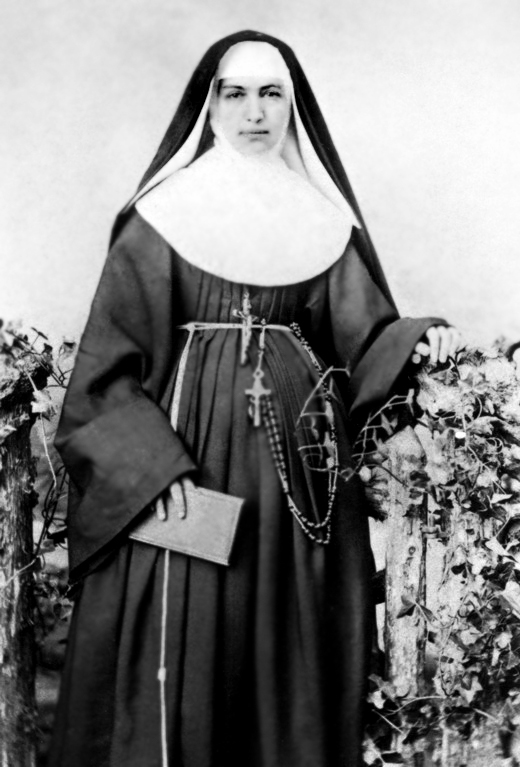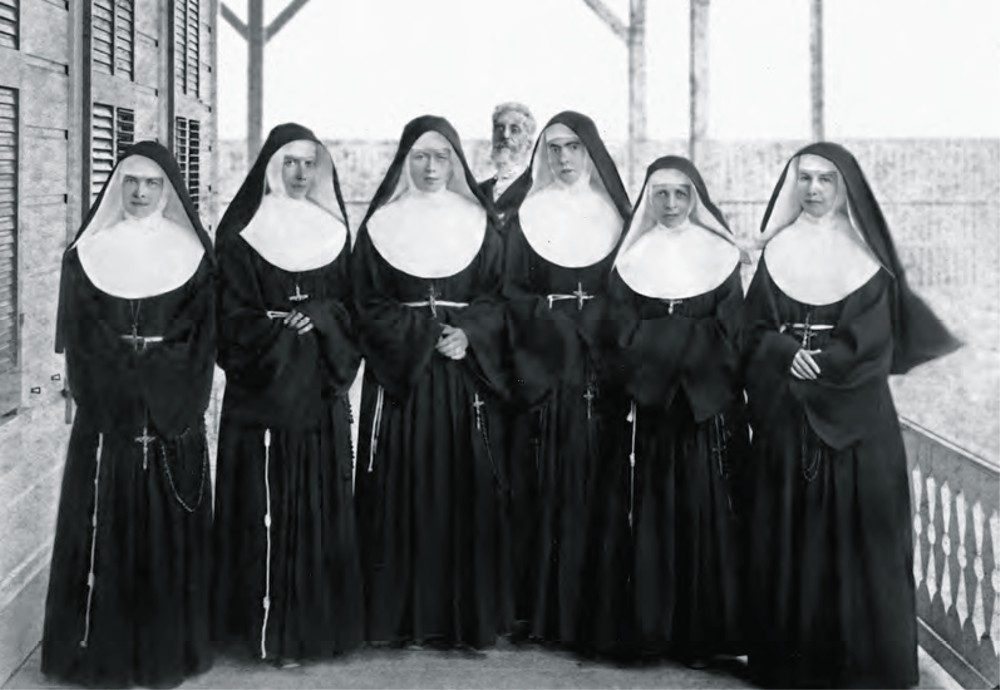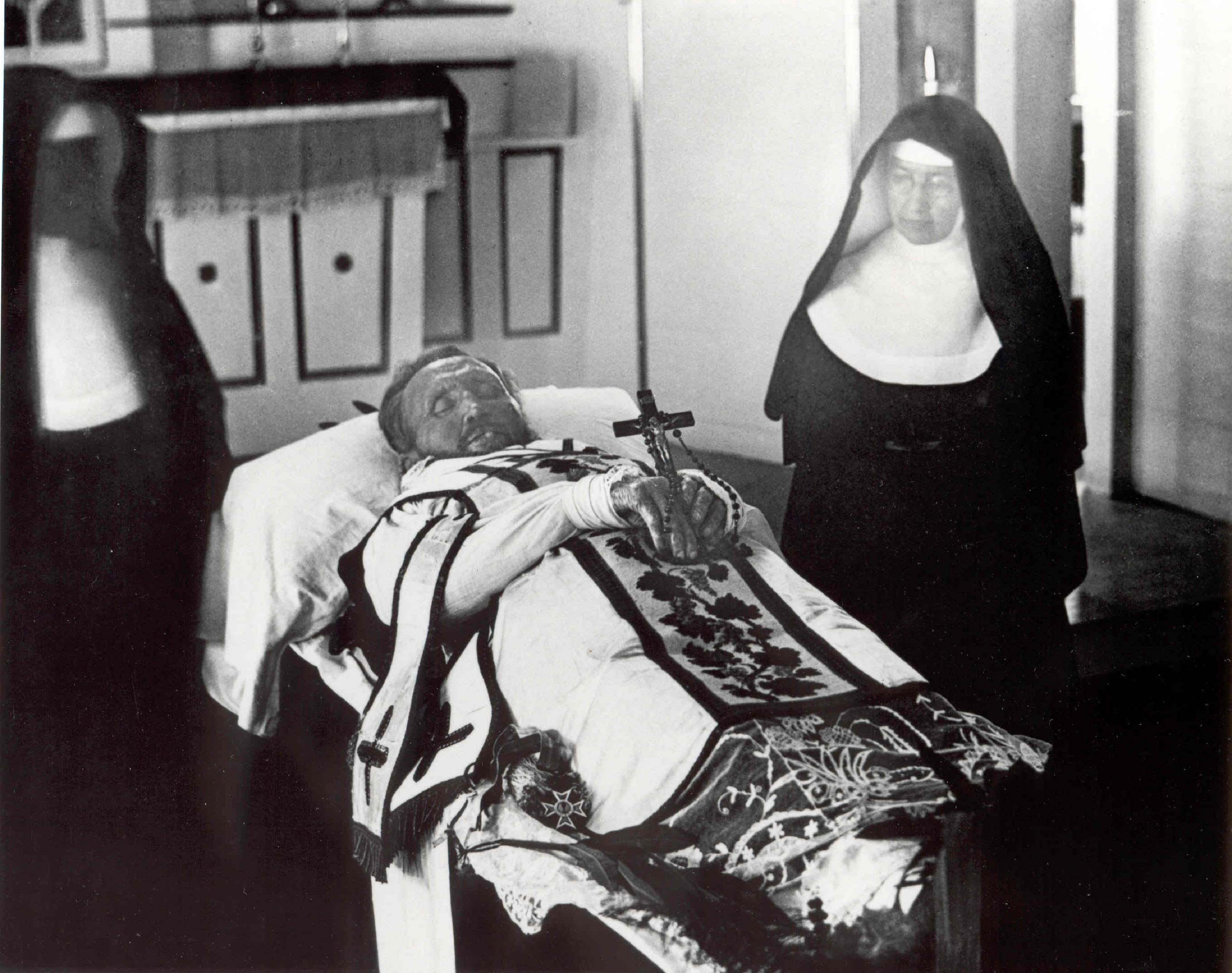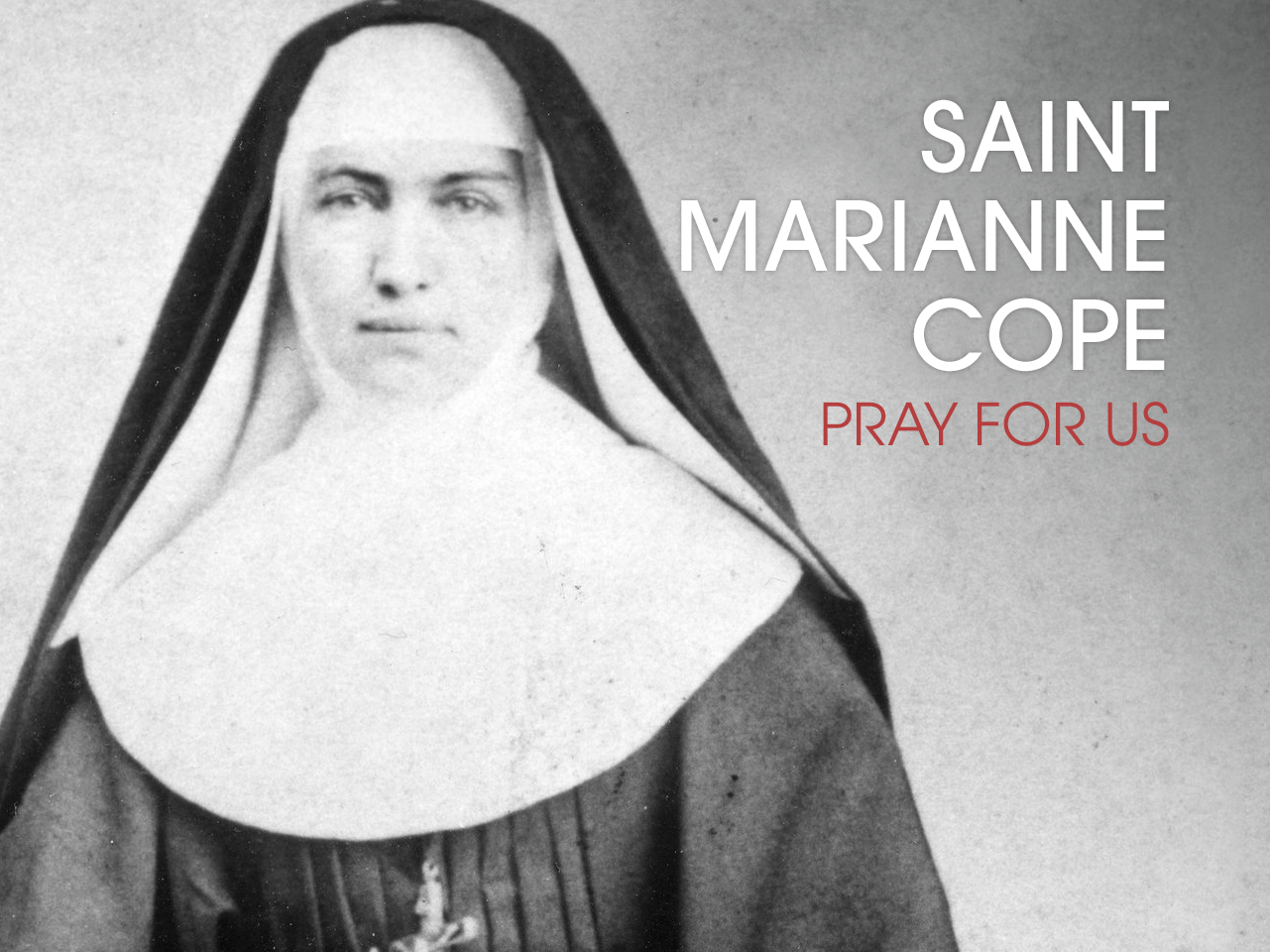-1883, Sister Marianne Cope, just before her departure from Germany to Hawaii.
In one of the most beautiful, colorful, loveliest, Eden-like places on earth, the cross of a horrific disease had turned everything grey; taken the taste out of life. It took the Gospel and a nun – in love with God and color – to bring joy back, for beauty to return to people’s lives:
Interview with Mother Marianne’s Nurse, Sister Magdalene, in 1941:
Utica Reporter: “Do the books and stories about Mother Marianne exaggerate her qualities?”
Nurse: “No, Mother Marianne was the gentlest, the cheeriest and the most dignified person you could imagine, and a disciplinarian, too.”
“She revolutionized life on Molokai, brought cleanliness, pride and fun to the colony. People on Molokai laugh now—like other people in the world, laugh at the same things, the same dilemmas and jokes.”
“It was Mother Marianne who bought the girls hair ribbons and pretty things to wear, dresses and scarves. Women keep their cottages and their rooms in the big communal houses neatly, pride fully. There are snowy bedspreads, pictures on the walls. They set their tables at meal time with taste, Mother Marianne brought that about.”
“She interested the women in color harmony. Sit in services at the back of the church in Molokai and observe the lovely arrangements of color of the women. When Mother Marianne went to the island, people there had no thought for the graces of life. ‘We are lepers,’ they told her. ‘What does it matter?’ Well, she changed all that. Doctors have said that her psychology was 50 years ahead of her time.”
Sister Magdalene was one of the nuns who attended Mother Marianne during her last illness, an old woman, but still valiant.
“She knew that the end was near but on that last day she insisted on joining the nuns at mealtimes. ‘No tears,’ she said. ‘Of course, I am coming to table. Why not?’ That night she died while we were at her bedside, August 9, 1918.”
On January 23, 1838, a daughter was born to Peter and Barbara Cope of Hessen-Darmstadt, Germany. The girl was named after her mother. Two years later the Cope family immigrated to the United States and settled in Utica, New York. Young Barbara worked in a factory until August 1862, when she went to the Sisters of the Third Order of Saint Francis in Syracuse, New York. After solemn profession of her religious vows, having taken the religious name Marianne, in November of the next year she began teaching at Assumption parish school.
Marianne held the post of superior in several places and was twice the novice mistress of her congregation. A natural leader, three different times she was superior of St. Joseph’s Hospital in Syracuse, where she learned much that would be useful during her years in Hawaii.
Elected provincial in 1877, Mother Marianne was unanimously re-elected in 1881. Two years later the Hawaiian government was searching for someone to run the Kakaako Receiving Station for people suspected of having leprosy. More than 50 religious communities in the United States and Canada were asked. None accepted. When the request was put to the Syracuse sisters, 35 of them volunteered immediately. On October 22, 1883, Mother Marianne and six other sisters left for Hawaii where they took charge of the Kakaako Receiving Station outside Honolulu; on the island of Maui they also opened a hospital and a school for girls.
In 1888, Mother Marianne and two sisters went to Molokai to open a home for “unprotected women and girls” there. The Hawaiian government was quite hesitant to send women for this difficult assignment; they need not have worried about Mother Marianne! On Molokai she took charge of the home that Blessed Damien DeVeuster (d. 1889) had established for men and boys. Mother Marianne changed life on Molokai by introducing cleanliness, pride and fun to the colony. Bright scarves and pretty dresses for the women were part of her approach.
Awarded the Royal Order of Kapiolani by the Hawaiian government and celebrated in a poem by Robert Louis Stevenson, Mother Marianne continued her work faithfully. Her sisters have attracted vocations among the Hawaiian people and still work on Molokai.
-1886, The Sisters of St. Francis, at the Kakaʻako Branch Hospital. Left to right: Sr. M. Rosalia McLaughlin, Sr. M Martha Kaiser, Sr M. Leopoldina Burns, Sr. M Charles Hoffmann, Sr. M. Crescentia Eilers, and Mother Marianne Cope. At center, rear: Walter Murray Gibson.
To the Reverend Sister Marianne
Matron of the Bishop Home, Kalaupapa
To see the infinite pity of this place,
The mangled limb, the devastated face,
The innocent sufferers smiling at the rod,
A fool were tempted to deny his God.
He sees, and shrinks; but if he look again,
Lo, beauty springing from the breast of pain!—
He marks the sisters on the painful shores,
And even a fool is silent and adores.
-poem by Robert Louis Stevenson
Kalawao, May 22, 1889
Mother Marianne Cope was beatified on May 14, 2005. Over one hundred faithful followers from Hawai‘i attended the beatification ceremony Rome. Three hundred followers from the Blessed Mother’s religious order in Syracuse were also in attendance. During the ceremony the Hawaiian song Makalapua was sung. The song was a favorite of Mother Marianne Cope.
Makalapua – The Opening Flower (Hawaiian traditional)
`O makalapua ulu mähiehie
`O ka lei o Kamaka`eha
No Kamaka`eha ka lei nä Li`a wähine
Nä wähine kïhene pua
Hui:
E lei ho`i, e Lili`ulani e
E lei ho`i, e Lili`ulani e
Ha`iha`i pua kamani (pauku) pua ki
I lei (ho`owehi) wehi no ka wahine
E walea ai ka wao kele
I ka liko io Maunahele
Lei Ka`ala i ka ua o ka naulu
Ho`olu`e iho la i lalo o Hale`au`au
Ka ua lei koko `ula i ke pili
I pilia ka mau`u nene me ke kupukupu
Lei aku la i ka hala o Kekele
Na hala moe ipo o Malailua
Ua maewa wale i ke oho o ke kawelu
Na lei Kamakahala o ka ua Wa`ahila
—-
The sweetest and most fragrant flowers of the garden
For the lei of Kamaka`eha
The goddesses of the forest weave a lei for Kamaka`eha
The ladies with baskets of flowers
Chorus:
Here is your lei, o Lili`ulani
Here is your lei. o Lili`ulani
Kamani leaves entwined with ti flowers
A lei to beautify the fair Lili`u
One who loves the beauteous and fragrant uplands
Where bud the flowers at Maunahele
Ka`ala wears a lei of rain and showers
Pouring down on Hale’au’au
Rainbow mist that is a lei on pili grass
Where nene grass grows close to kupukupu ferns
Wearing a lei of hala fruit of Kekele
Hala of Malailua that lovers dream of
Swaying freely amid kawelu grasses
Kamakahala flower leis of Wa`ahila rain
This song incorporates both names of the Queen Lili’uokalani, Hawaii’s last monarch: Lili`u (smarting) and Kamaka`eha (sore eyes) a name given to her at birth by Kina`u, her grand aunt who was suffering from sore eyes at that time. It was a Hawaiian custom to name a child for an important event at the time of their birth. Maunahele was the name of the gardens in the shadow of the pali on the windward side. These gardens were sacred to Lia, the mountain goddess of flowers. The Kamani tree (calaphyllum inophyllum) native of Hawaii has edible nuts and fragrant flowers. The ti or ki (cordyline ternminalis) an indigenious plant has leaves that are used for cooking, thatching houses and making hula skirts. The fibrous roots when cooked make a sweet candy and when fermented, produce an intoxicating beverage.
-April 15, 1889, Mother Marianne with funeral bier of Fr Damien of Molokai.
“The charity of the good knows no creed and is confined to no one place.” (1870’s)
“I do not think of reward; I am working for God, and do so cheerfully.” (1902)
“I am hungry for the work… I am not afraid of any disease, hence it would be my greatest delight even to minister the abandoned ‘lepers.'”
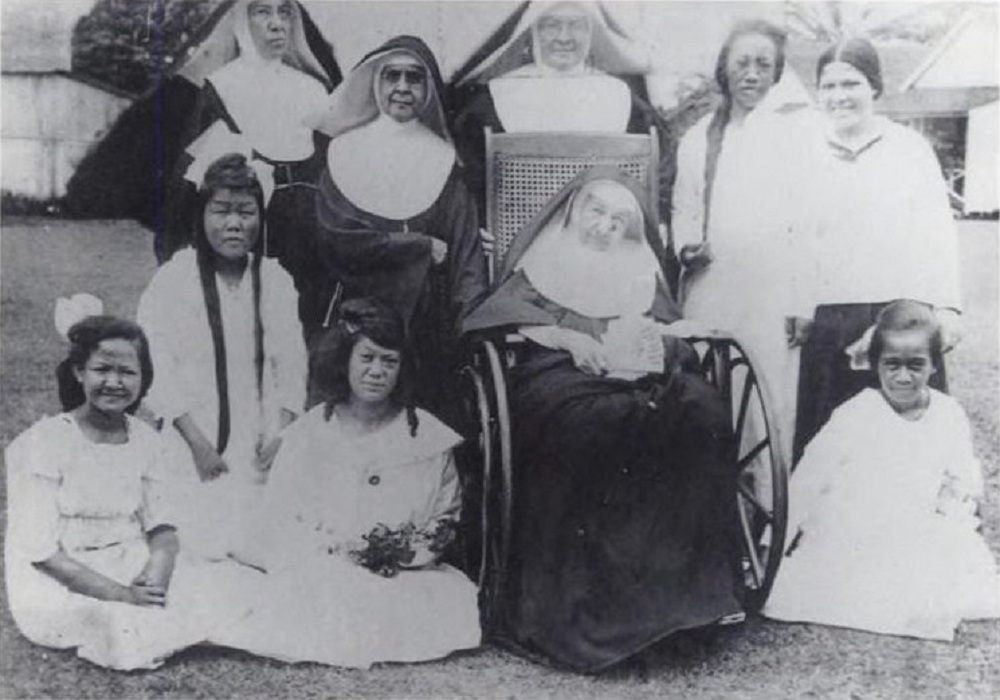
-Mother Marianne Cope, a few days before she died, with sisters and patients, 1918.
Love,
Matthew

